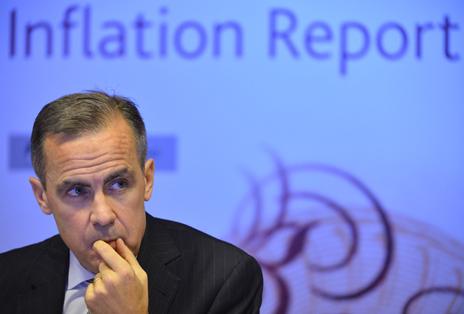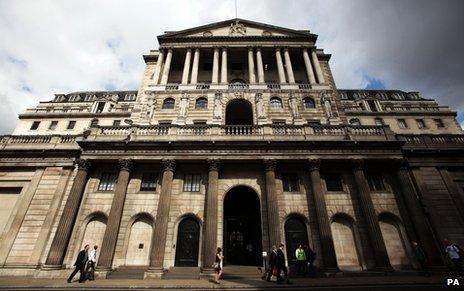Is prudential tinkering our salvation?
- Published
- comments

Mark Carney, the governor of the Bank of England
We live in a developed western world where the heuristics of economics, the normal policy responses learned through past experience, seem irrelevant.
As just two examples, neither the US or UK economies have bounced back in the way history has suggested they should have done since the financial crash and shock of 2007-8. In the UK for example, GDP (national income) is a fifth lower than it would have been, had the pre-crisis trends resumed.
But, as the governor of the Bank of England reminded us last night in a speech in New York, if the unemployment rate had risen as it has done in previous periods of recession and stagnation, it would today be 14% in the UK, as opposed to the current 7.6%.
Or to put it another way, there is good and bad news in our recent economic performance. That said, economists being economists don't always see the ostensible good news as benign. So, for example, the growth of employment at a time of anaemic recovery is seen by some as evidence that there has been a permanent reduction in productivity, which reduces our long-term growth prospects.
As it happens, that pessimism isn't shared by the Bank of England, though the government's Office of Budget Responsibility appears more prone to the glass-half-empty view.
The background to Mark Carney's speech last night was the recent short address, external by the former US Treasury Secretary, Larry Summers, which raised the prospect that the rich West entered a period of secular or semi-permanent stagnation several years before the 2007-8 debacle.
Summers' evidence is that in spite of the mother of all lending splurges in the early years of this century, there was no dramatic boom in output, and conventional inflation remained relatively low.
Now the fundamental causes of this secular stagnation would be a permanent diminution in the competitiveness of economies such as the UK's, caused by the rise and rise of the likes of China, and the failure of consumers in places like China to spend like we do and buy our stuff.

Larry Summers
All of which is plausible, and was the stuff of academic and political argy-bargy long before global financial capitalism cracked.
But it carries a striking implication for the behaviour of central banks such as our own Bank of England.
Here is one way of looking at the structural problem.
Because the Chinese and German and Japanese and oil-producing Arabs saved (and save) so much, and because the majority of western consumers spent (and spend) so much, our debts rose to unsustainably high levels.
Or to put it another way, intractable global imbalances - to use the ghastly jargon - remain the root of all our woes.
It all means that the so-called equilibrium interest rate required to keep us spending and the economy moving forward is less than zero.
And what's worse, that equilibrium interest rate may be negative for years and years and years to come.
You may by now be holding your head in some pain and wondering what on earth I am going on about.
Surely interest rates cannot be less than zero.
Well they can in two senses.
First they can be negative when inflation is taken into account, as is demonstrably the case in the UK.
Here is what Carney said last night: "The Monetary Policy Committee judges that the equilibrium real interest rate has been and continues to be negative."
And, as it happens, central banks have the ability to, in effect, tax banks that put money on deposit with them, by charging a genuine negative interest rate, in order to dissuade the banks from keeping their money safe at the central bank and incentivise them to lend it to households and businesses.
As it happens, the Bank of England has never done this, largely because it is not clear whether it would have the desired result. Banks might, for example, end up charging more for loans, to compensate for their losses at the central bank.
However, the reduction in the rate for central bank deposits to less than zero is under active consideration by the European Central Bank - which shows, as if you didn't know, that the eurozone's long bitter credit winter shows no sign of ending any time soon, and that further evasive action is needed.
As for the UK, Carney faces both ways.
On the one hand, he does not reject the idea that the UK is suffering from endemic, secular stagnation - although it is not his preferred view.

Which is why, in his words, the Bank of England and other central banks have "set monetary policy at emergency levels by reducing short-term interest rates to their lowest feasible levels, undertaking large-scale asset purchases and pursuing targeted interventions to ease funding and credit conditions".
Carney is less pessimistic than Summers. He believes that the exceptional monetary stimulus being provided by the Bank of England will - in time - lead to a return to growth of a sustainable sort that isn't so different from what we enjoyed in the past, and would allow interest rates to eventually return to "normal" levels.
In that context, he is bullish about the strength and durability of the current recovery in the UK.
But here is what matters. In spite of the UK economy currently growing at an annualised rate of more than 3% - the "natural" rate before the Crash - he says that "it is unlikely that equilibrium interest rates will return to historically normal levels any time soon".
Because if interest rates did rise, the indebtedness of consumers and government, and the absence of compensating demand for UK goods and services from abroad, means that recovery would be precipitately choked off.
Isn't all this rather scary, given that Carney acknowledges that the debts or leverage of households remain high by historical standards, and that spending by consumers is simultaneously fuelling the recovery and undermining the repair of households' balance sheets?
Or to put it another way, a consumer-led recovery is simultaneously doing good and bad.
Not to worry, says Carney. He and his colleagues saw this coming, and they have a cunning plan to nurture the fledgling recovery while warding off the dangers that it will lead to a dangerous amplification of debts that would see us return to 2008-style banking crisis.
That plan is to see the Monetary Policy Committee and the new Financial Policy Committee, created by the Chancellor, working in tandem - with the MPC setting negative real interest rates, and the FPC making sure banks don't allow consumers and businesses to become dangerously indebted.

The FPC recently acted to divert Bank of England funds away from mortgages
So, for example, the FPC has already modified the Funding for Lending scheme, so that cheap Bank of England funds are diverted from mortgages - where there has been a revival of supply - to small business lending, where there is still a bit of a drought.
And in the future the Bank of England's FPC could tighten underwriting standards for loans and force banks to undertake more stringent affordability tests. Or it could stem the pace of lending by obliging banks to hold more expensive capital relative to the loans they make. Or it could advise the government to reduce the supply of guarantees for mortgages under its Help-to-Buy scheme.
Here is what I think is striking.
Much of this feels like the prudential equivalent of the kind of fiscal tinkering - short term modifications of taxing and spending to stimulate or rein in growth - that was so beloved of government in the 1960s and 1970s.
Fiscal tinkering became discredited because it was seen to be creating too much uncertainty for businesses and households, which found it harder to make rational investing and spending decisions.
Fiscal tinkering was seen to be undermining the UK's long-term rate of growth.
Which at a time when Summers worries the long-term rate of growth in the UK is close to zero is not - maybe - a danger we need to worry about.
Prudential tinkering, to prevent a consumer-led economic revival collapsing rapidly into financial mayhem, may well be smart and imaginative.
But it is not impossible to think of it as ultimately becoming a deterrent to sensible, wealth-creating lending and investing.
Or to tell you what you probably know, each era's solution to an economic crisis contains within it the causes of the subsequent crisis.